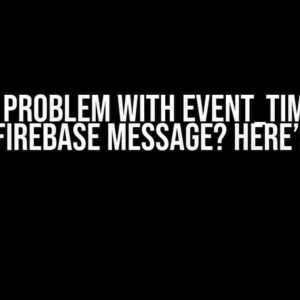Are you tired of scratching your head over Bluetooth Low Energy (BLE) characteristic reading issues? Do you find yourself stuck in a never-ending loop of errors and frustrations? Fear not, dear developer, for we’ve got you covered! In this comprehensive guide, we’ll walk you through the most common problems reading BLE characteristics and provide you with actionable solutions to get your project back on track.
Understanding BLE Characteristics
Before we dive into the nitty-gritty of troubleshooting, let’s take a step back and understand what BLE characteristics are and how they work.
How BLE Characteristics Work
A BLE characteristic consists of three components:
UUID: A unique identifier assigned to the characteristic.Properties: Define how the characteristic can be accessed (read, write, notify, etc.).Value: The actual data stored in the characteristic.
When a BLE device wants to read or write data to a characteristic, it sends a request to the device that exposes the characteristic. The requesting device is called the client, and the device that exposes the characteristic is called the server.
Common Problems Reading BLE Characteristics
Now that we’ve covered the basics, let’s explore the most common problems you might encounter when reading BLE characteristics.
1. ** Connection Issues **
One of the most frustrating issues is when your app can’t connect to the BLE device. Check the following:
- Ensure the BLE device is turned on and in range.
- Verify that your app has the necessary permissions to access the BLE device.
- Check the UUID of the service and characteristic you’re trying to access.
// Example code to connect to a BLE device
noble.scanForPeripheralsWithServices(['UUID_OF_SERVICE'], true);
// Listen for the 'discover' event
noble.on('discover', (peripheral) => {
console.log(`Discovered ${peripheral.id}`);
peripheral.connect((error) => {
if (error) {
console.log(`Error connecting: ${error}`);
} else {
console.log('Connected!');
}
});
});
2. ** Authentication and Encryption **
Sometimes, BLE devices require authentication and encryption before allowing access to characteristics. Ensure that:
- You’ve paired the BLE device with your app.
- You’ve successfully authenticated with the device.
- Encryption is enabled (if required).
// Example code to authenticate with a BLE device
peripheral.authenticate((error) => {
if (error) {
console.log(`Authentication failed: ${error}`);
} else {
console.log('Authenticated!');
}
});
3. ** Characteristic Not Found **
If you’re trying to read a characteristic that doesn’t exist, you’ll get an error. Double-check that:
- The characteristic UUID is correct.
- The characteristic is part of the service you’re trying to access.
// Example code to read a BLE characteristic
peripheral.discoverCharacteristics(['UUID_OF_CHARACTERISTIC'], (error, characteristics) => {
if (error) {
console.log(`Error discovering characteristics: ${error}`);
} else {
console.log(`Found ${characteristics.length} characteristics`);
characteristics.forEach((characteristic) => {
console.log(`Characteristic UUID: ${characteristic.uuid}`);
});
}
});
4. ** Permission Issues **
Ensure that your app has the necessary permissions to access the BLE device and characteristic. Check that:
- Your app has the required permissions in its manifest file.
- The user has granted the necessary permissions.
// Example Android manifest file
<uses-permission android:name="android.permission.BLUETOOTH" />
<uses-permission android:name="android.permission.BLUETOOTH_ADMIN" />
5. ** Device-Specific Issues **
Sometimes, BLE devices have specific requirements or quirks that can cause issues. Consult the device’s documentation and:
- Check for firmware updates.
- Verify that the device is in the correct mode (e.g., advertising or peripheral mode).
Troubleshooting Techniques
When faced with a problem reading BLE characteristics, try these troubleshooting techniques:
1. ** Enable Debugging **
Enable debugging on your BLE device and inspect the logs to identify the issue.
// Example code to enable debugging
peripheral debug = true;
2. ** Use a BLE Sniffer **
Use a BLE sniffer tool to capture and analyze the BLE communication between your app and the device.
| BLE Sniffer Tool | Description |
|---|---|
| nRF Sniffer | A popular BLE sniffer tool for Windows, macOS, and Linux. |
| Bluetooth Explorer | A GUI-based BLE sniffer tool for Windows and macOS. |
| hcitool | A command-line BLE sniffer tool for Linux and macOS. |
3. ** Analyze Error Codes **
When an error occurs, inspect the error code and message to determine the cause of the issue.
// Example error handling code
peripheral.readCharacteristic('UUID_OF_CHARACTERISTIC', (error, data) => {
if (error) {
console.log(`Error reading characteristic: ${error}`);
console.log(`Error code: ${error.code}`);
console.log(`Error message: ${error.message}`);
} else {
console.log(`Read characteristic successfully: ${data}`);
}
});
Conclusion
Reading BLE characteristics can be a daunting task, but with the right knowledge and troubleshooting techniques, you can overcome even the most puzzling problems. Remember to:
- Understand the BLE characteristic structure and properties.
- Verify connection, authentication, and encryption.
- Check for characteristic existence and permissions.
- Consult device-specific documentation and enable debugging.
- Use BLE sniffer tools and analyze error codes.
By following this comprehensive guide, you’ll be well-equipped to tackle any BLE characteristic reading issue that comes your way. Happy coding!
Frequently Asked Question
Having trouble reading BLE characteristics? Don’t worry, we’ve got you covered! Here are some frequently asked questions to help you troubleshoot and get back on track.
Why can’t I read BLE characteristics on my device?
Make sure your device supports BLE and that it’s enabled! Also, check if you have the necessary permissions to access the BLE device. Additionally, ensure that the BLE device is in range and not connected to another device.
What are the common errors I might encounter while reading BLE characteristics?
You might encounter errors like “Characteristic not found”, “Device not found”, “Gatt error”, or “Timeout”. These errors can be due to various reasons such as incorrect UUID, device not in range, or connection issues.
How do I debug issues with reading BLE characteristics?
Use debugging tools like Android’s built-in Bluetooth HCI log or iOS’s Console app to logs to identify the issue. You can also use third-party libraries or tools to visualize the BLE communication and identify the problem.
What are the best practices for reading BLE characteristics efficiently?
Use a dedicated thread or queue for BLE operations, and batch read characteristics to minimize the number of requests. Also, implement exponential backoff for retries and handle errors gracefully to avoid crashing your app.
Can I read BLE characteristics in the background on both Android and iOS?
On Android, you can use aForeground Service to read BLE characteristics in the background. On iOS, you can use Core Bluetooth’s State Preservation and Restoration to continue scanning and reading BLE characteristics in the background. However, there are limitations and restrictions on both platforms, so be sure to check the documentation!




